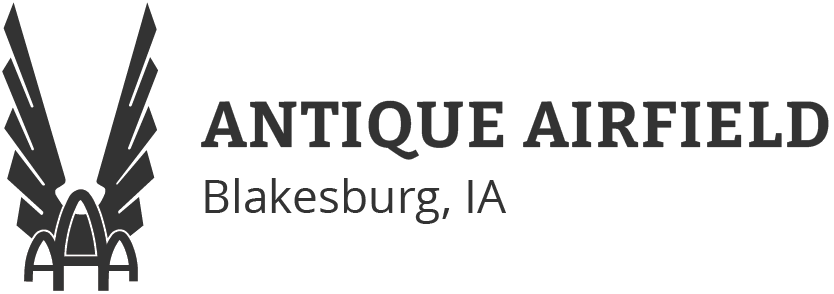Fly-in & Airfield Rules
For all pilots planning to fly into Antique Airfield during the National AAA/APM Fly-in, the owners/operators of Antique Airfield, as well as the Board of Directors of the AAA/APM, would appreciate your cooperation in making our annual Fly-in a safe and enjoyable event for all.
The annual AAA/APM Fly-in is a closed, private event open only to members of the AAA and their guests. If you plan to attend and are not an AAA member or guest of an AAA member, then you will be required to join the AAA; no exceptions. Membership in other aviation organizations or an airman’s certificate will not qualify one for admittance into this Fly-in.
This Fly-in is held on private property that receives no federal, state, or local monies. While we welcome anyone with a sincere interest in antique/classic aircraft to join the AAA, we do not have the room, facilities, or manpower to handle the general flying public, nor can we afford the liability exposure that allowing the general public into this event would create.
If you are planning on flying into Antique Airfield and are not used to operating in and out of a 2350 ft grass runway, we encourage you to find an appropriate airport in your area on which to gain currency and proficiency in short-field operations before arriving at Antique Airfield.
Antique Airfield is on the Chicago Sectional on a 1200 ft base airway. Please note there is a 354 ft (agl) 1258 ft (msl) microwave tower 1 1/2 miles SW of the field.
Antique Airfield’s main runway runs N-S and is 2350 ft in length. During the Fly-in, our E-W runway is closed and used strictly for a taxiway and aircraft parking.
Windsocks are located on top of Hangar #1 (#7 on the airfield map) and at the APM Restoration Center (#5 on the map). A wind tee is located just to the NE of the runway intersection (#14 on the map). If you are not familiar with operations in a non-radio/non-controlled airport, please review these operational skills with a qualified individual or flight instructor before flying into Antique Airfield.
The wind tee will be tied to show the active runway (N-S). Antique Airfield has a standard left-hand traffic pattern only. Pattern altitude is 700 ft (agl) or 1600 ft (msl) for all traffic. No straight-in or base-leg-to-final approaches are allowed. We encourage you to overfly the airport at 2000 ft (msl) to check traffic, wind direction, and which runway is in use. Then descend and make a standard pattern entry for left-hand traffic.
There is no Unicom nor any form of radio communication when operating in or out of Antique Airfield. Please keep your head up and your eyes out of the cockpit and encourage your passengers to do the same. As pilot-in-command, you are responsible for the safe operation of your aircraft in and out of Antique Airfield.
Plan on arriving overhead with enough fuel to make several attempts at landing due to heavy traffic in the pattern and vicinity of Antique Airfield. If your fuel situation, weather conditions, or other factors dictate, please plan to divert to nearby area airports such as Ottumwa, Oskaloosa, Albia, Centerville, or Bloomfield.
Once on final approach into Antique Airfield, watch for the flagmen at the approach-end of the runway and follow his signals. If he is waving his flag up in the air, it is directed at you, the landing aircraft. If you are given a red flag, initiate a go-around immediately. When landing to the south, be wary of downdrafts and please note the first 400 ft of runway slopes uphill. When landing to the north, be aware of the five-wire fence on the south end of the runway.
Once on the ground and slowed to an appropriate and controllable taxi speed, please exit the runway on the east side (see the airport map). Under no circumstances should you exit the runway and taxi on the west side. Do not stop on the runway under any circumstances as there may be traffic landing very close behind you. Please taxi back toward the parking areas alongside, not on, the active runway due to landing and departing traffic. Please obey the signals of the flagmen at all times and those marshaling you to an appropriate parking area. Do not taxi into any unmowed areas.
When departing Antique Airfield, please check the wind tee and traffic to determine the proper direction and then taxi out to the active runway. Please try and conduct your runup and checklists while on the taxiway. The flagmen will direct you (flag held low and pointed at you) to hold on the taxiway, taxi into position, and hold and/or clear for takeoff. Once given the green flag for takeoff, do not delay and initiate your takeoff immediately as there may be traffic landing behind you. Use of a smoke system (for aircraft so equipped) on takeoff is forbidden!
There are positively no nighttime operations into or out of Antique Airfield so plan accordingly.
You are required to bring aircraft tie-downs with you and all aircraft will be tied down at sunset, with no exceptions. Weather patterns in Iowa change quickly so it’s a good idea to have your aircraft tied down anytime you are not immediately around it.
A pilot’s briefing will be held daily at 10:30 a.m. on the porch of the Ground Loop Inn (#1 on the airfield map). If you plan to go flying during the day (and we hope that you do) your attendance at this briefing is required.
Finally, please be advised that children under sixteen are required to have adult supervision on the flight line at all times to ensure their safety.
If you do not agree or feel comfortable with any of the above operations/regulations, please do not risk your airplane or person by operating into Antique Airfield.
